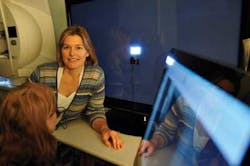Vision system detects peripheral field loss
Peripheral visual field loss in children can be caused by brain tumors that interfere with the visual pathway from theoptic nerve at the front of the brain to the visual cortex at the back.
Unfortunately,assessing visual field loss in young children is very difficult. Current techniques mean that subjects must sit still and maintain a steady gaze at a light target for as long as 10 min.
Now, a vision-based system developed by Dr. Louise Allen, a pediatric ophthalmologist at theUniversity of Cambridge (Cambridge, UK), and Adar Pelah, PhD, an electronics engineer at the University of York (York, UK), can detect visual field loss in young children in a more accurate, child-friendly fashion.
Using the KidzEyez system, a child watches a cartoon in the center of a video screen, while their response to a target appearing in different locations of the visual periphery is monitored remotely using a camera. If the target falls within the intact visual field, the child will reflexively look at the target. If the target falls within a blind area, no response will be seen.
The KidzEyez system has been funded by Cambridge Enterprise, the University's commercialization group, and the University of York. Cambridge Enterprise is currently seeking commercial partners for licensing, collaboration, and development of this technology.
More Vision Systems Issue Articles
